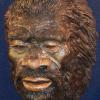I'm glad you asked those questions.
As I've mentioned before, my experiences with the subject animals and their behaviors are based on field work in the twelve Central/Southeastern states, so as you mentioned, "Your mileage may vary". Most of the field work was done in general locations known to be inhabited by one or more family groups of Bigfoot. Initially – nearly 50 years ago and for a few years after that – most all of that field work was done in the Ouachita Mountains of Arkansas or in the Saline River bottoms south of the mountains. (All four forks of that river originate in those mountains.) The locations were known Bigfoot areas to me and others because they and their tracks had been seen there. Their vocalizations and physically generated noises were heard many times in those areas.
The Bigfoot areas in which I did field work in other parts of Arkansas and in other states were brought to my attention by credible local residents, including law enforcement officers, hunters, timber men, seismic crew leaders (working in the swamps of South Alabama) and even by a rocket scientist who had a small group on his property in North Alabama. In about 50% of that field work I was accompanied by one or more of these folks who had encountered the animals.
These foraging areas were not like those vast, remote and uninhabited areas in the Pacific Northwest. In fact, most encounters were in areas in which Bigfoot could have accessed rural homesteads during one night of foraging. In several documented cases, Bigfoot's home/bedding areas were found on some of those homesteads.
It well known by many researchers that the males will leave the family bedding areas about one hour before full darkness. During that time they move slowly, cautiously and intermittently in areas of thick trees or brush. When they stop, they stand so motionless for so long, it is difficult for a person watching them to see them clearly until the Bigfoot takes another step. (A very good and detailed report of this situation is described in Case 13,”The Notorious Pursuit” in the book I scribbled.) That documented event also describes and unusually aggressive and prolonged chase of the hunter by the Bigfoot he had seen..
Normally, when each male gets some distance away from the family’s bedding area, he will either start vocalizing with his unique yell, holler or by a series of “tree knocks”. These sounds will nearly always begin right at the time of full darkness, and are simply “gathering calls” directed at their other male neighbors who are their hunting partners at night. When I said this was normally the case, it refers to males from small family groups that bed in hearing distance of each other. When they know people are in the general area they often communicate with their peers by whistling, imitating the sounds owls, crows or canines.
On one particular night in Clarke County, AL about a dozen of us – in four or five vehicles - arrived on a hillside above a very large swamp, and within a few minutes, that swamp became alive with the sounds of several Bigfoot loudly and repeatedly beating on trees. We could only estimate there were about seven of the creatures that we could hear distinctly. These sounds were not really aggressive in nature or intent, but simply a clear message to us that they were displeased that we were interfering with their hunting schedule. That was somewhat confirmed when on the hill above us another Bigfoot began a series of even louder and faster paced knocking on one of the few large oak trees on the hillside. (We were all parked in what had been the yard of an old home place.) The knocking was so close that a “newbie” couple, who had brought their two kids on the outing, rightly decided they should not be there and left immediately.
The rest of us came to the conclusion that the Bigfoot on the hill was a scout for the group in the swamp. He no doubt seen and heard our vehicles turn off the county road – which runs between the hill and the swamp - and onto the old road to the vacant home site. The scout was probably beating the tree as we slowly drove up the hillside, but we didn’t hear it for the noise of the vehicles. Clearly, we were getting a “Not Welcome” message. The racket continued for a good while, and we could hear large green limbs or small trees being broken occasionally as the group in the swamp moved away from us in the edge of the swamp near the road. We never heard the one on the hill again. Apparently, that one on the hill was scouting for and guiding those in the swamp to high ground hunting/foraging areas. They didn’t try to intimidate or run us off, they just moved further down the swamp to go to higher ground.
It is well known that the level of aggressive sounds and actions of Bigfoot directed at humans are nearly always the direct result of actions or inactions of humans themselves..
Chance encounters between humans and Bigfoot – when both are simply in transit -can be frightening to both. Bigfoot may scream, growl or roar, but the sounds are likely to be induced by surprise or alarm. In such cases, the situation is are usually resolved when each entity go their separate ways at “warp” speed. In such cases there is no real aggression involved.
Bigfoot are very curious about humans and our actions while in their territory. They often closely approach occupied camp sites, usually after midnight and when they can hear people snoring or completely silent. They are primarily looking for food, but unlike other animal scavengers, they don’t usually make a mess while doing so. They are “neat freaks”. If they accidently make a loud noise while rummaging, and they hear that someone is awakened, they may simply execute their “fall and hide” maneuver. If no one shows themselves, the Bigfoot may lay silently for a good while until the campers are asleep again. Of course, if someone makes sounds that indicated they are coming outside, the Bigfoot will simply leave the campsite as quietly as possible. It is rare if they remain to make aggressive sounds when a person comes outside.
The signs of real aggression become apparent when people accidently or deliberately encroach on the “home turf” of a family of Bigfoot, day or night. It is practicality impossible for a person to get even close to a family group or their bedding area without the males of the group knowing it. Those males, acting as sentries, will be watching anyone closely long before that person actually gets close enough to the females and the young to pose any risk or danger to them. When a person reaches the “no admittance” boundary, the males’ responses will usually consist of them either breaking large green limbs or pushing over dead trees. If the person assumes that the limb break or tree fall was a natural event and continues walking, one or two more limb breaks or tree falls will convince the intruder of their presence. If folks ignore those actions, and the event occurred at night the Bigfoot may either begin throwing rocks or make a growling or screaming bluff charge toward the intruder. When the encounter reaches this point that person will, whether he/she knows it or not, be under close surveillance by another male at a point opposite the male being covertly aggressive.
Most of the year, the Bigfoot families as group don’t move around much during the day, but during periods of high temperatures and drought they make several group visits to fresh water sources daily. The males are hypersensitive and on full alert when escorting the females and young to water during the day. If a person is detected near the water source, the males go directly into a vocal rampage of earsplitting roaring, screaming and hooting. The vocalizations will be augmented by trees being shaken or broken. (To me and others, the loud hooting sounds are indistinguishable from those made by silverback gorillas.) The other family members may be heard running away but the male(s) will stay until the human(s) leave the area.
The most dangerous situation that people can create for themselves is to invade and attempt to dominate a remote area known to have been inhabited for generations by a large group of Bigfoot. (Any such area in which four or five juvenile Bigfoot can be seen playing in the timber is prima-facie evidence that a large group of Bigfoot inhabits and resides there.) When the invasion is for the sole purpose of killing one of the creatures without expecting the Bigfoot to react in kind is beyond comprehension. Over time, the reaction of the Bigfoot clan will proceed from tree knocking, to vocal intimidation to rocks being thrown into the camp area, then at the camp house/tent, then at individuals. If the invasion and attempts to dominate the area and the creatures continues, one of the older males of the clan may reach through the tent flap or window to take someone out behind the barn.
During the ten years I worked in the Amazon Basin of Brazil there are two pertinent and absolute things I learned about wild primates. (1) They can and do recognize the face and body of a human that has abused them, years after the event. (2) They do carry a grudge, and are methodical and unmerciful in their revenge.




